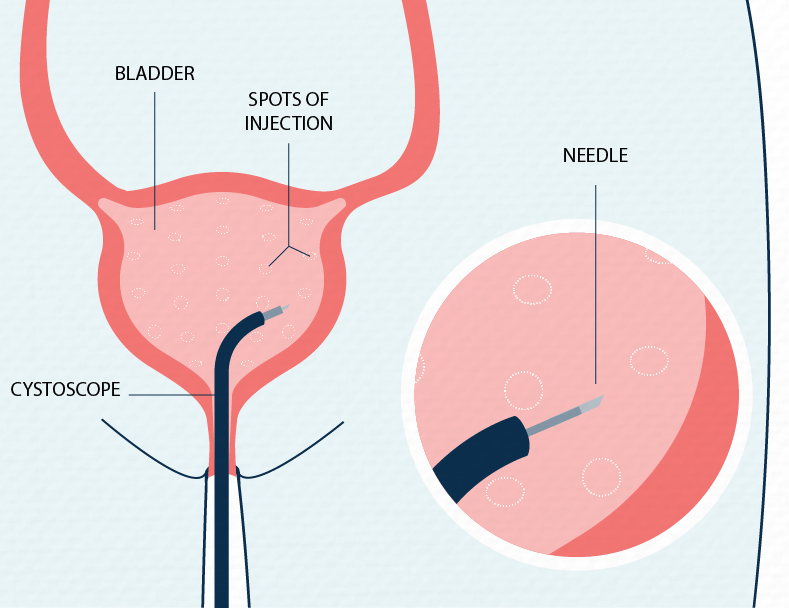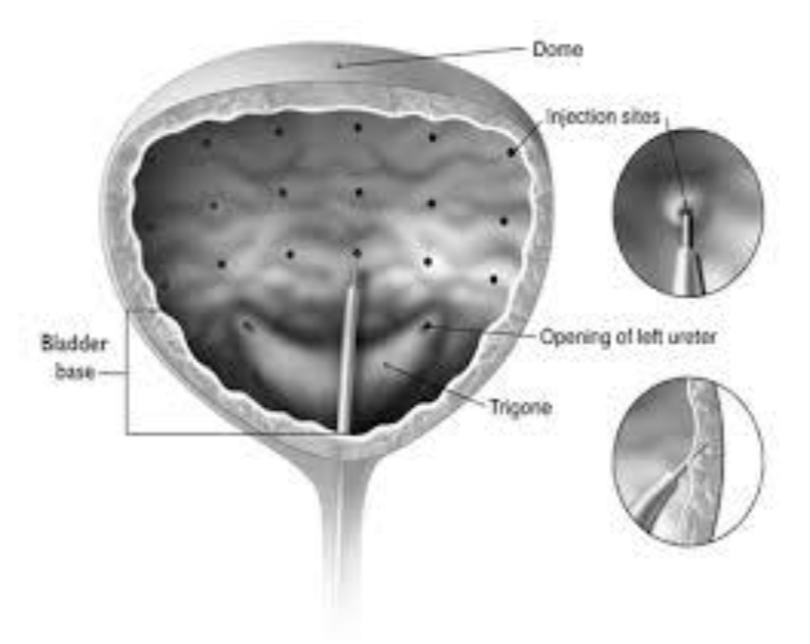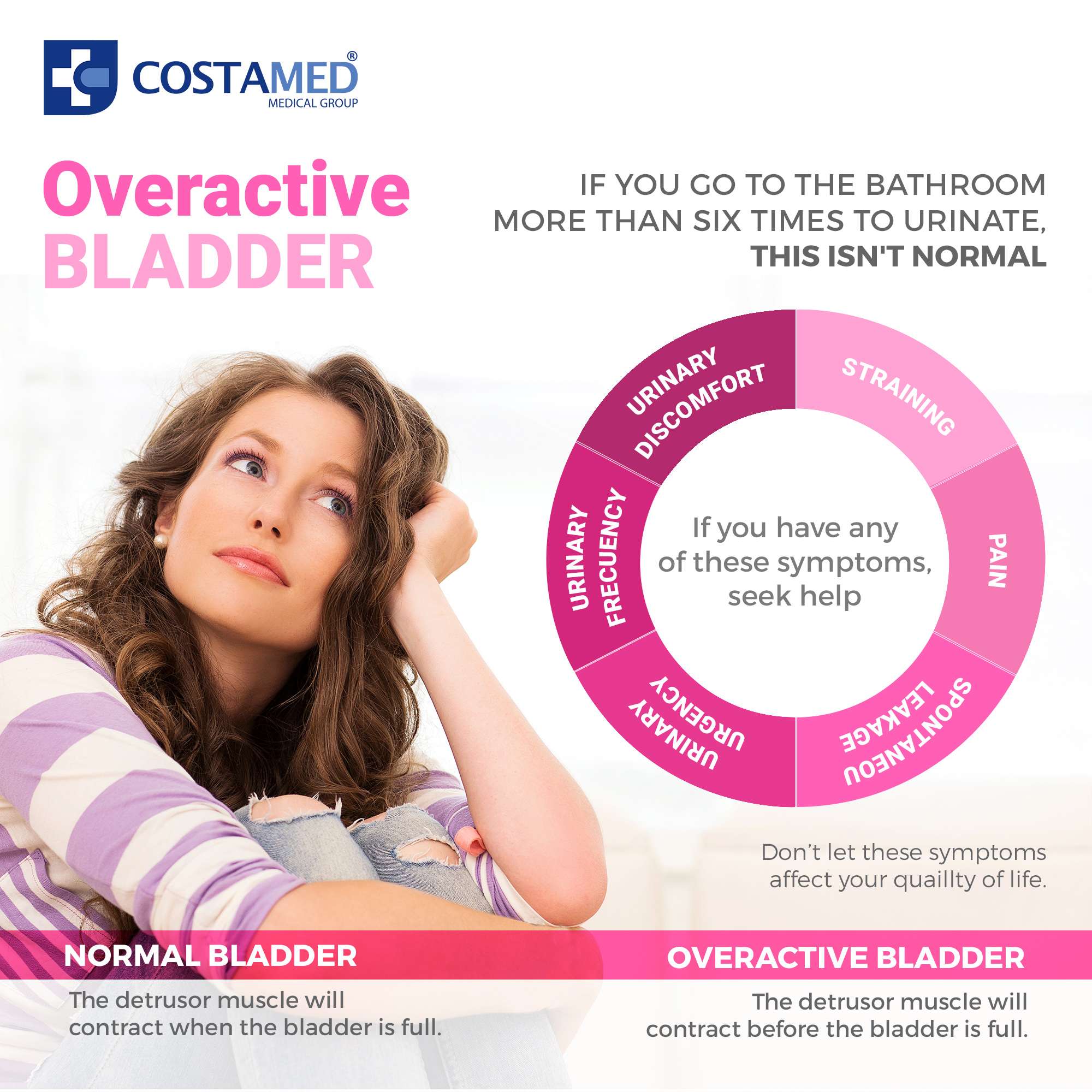What To Expect: Botox Injection For Overactive Bladder
Youve probably heard of Botox being used to improve the cosmetic appearance of facial wrinkles. However, botox has many medical uses that go beyond improving ones appearance. For example, botox is commonly used to improve internal body functions. In the field of urology, it can be injected into the bladder muscle to improve symptoms of overactive bladder .
What is botox?
Botox is derived from the most poisonous substance known to manbotulinum toxin. This neurotoxin is produced by the Clostridium bacterium, responsible for botulism. Botulism is a rare but serious illness that can result in paralysis. Botulinum toxin, when used in minute quantities in a derivative known as botox, is a magically effective and powerful potion.
How does botox work?
Botox is a neuromuscular blocking agent that weakens or paralyzes muscles. Beyond cosmetics, it can be beneficial for a variety of medical conditions that have some form of localized muscle overactivity. Botox is generally used to improve conditions with muscle spasticity, involuntary muscle contractions, excessive sweating and eyelid or eye muscle spasm.
Botox to treat Overactive Bladder
Overactive Bladder syndrome can be described by the symptoms of urinary urgency , with or without urgency incontinence . Its usually accompanied by frequent urination during both day and night hours. OAB has been described as the bladder squeezing without your permission to do so.
What to expect during a bladder botox injection
How Is Botox For Overactive Bladder Placed
To treat overactive bladder, the botox needs to be injected in the bladder with a small needle. First, an assistant places an anesthetic liquid in the bladder to numb it. Then, I perform a cystoscopy which lets me see into the bladder. Finally, I inject the botox, usually in ten different places throughout the bladder. The most common starting dose is 100 units. This procedure is usually done in an office setting but can be done in an operating room. The worst part of bladder botox is being instirrups for 15+ minutes. I talk my patients through the procedure so they know exactly what I am doing. I also make sure that they know they can ask me to stop or take a break. It always goes a little smoother if they feel like they have a active voice and are participating in the process. You can see more information from the botox company here.
About Oab And Detrusor Overactivity
OAB and detrusor overactivity can both cause trouble with urination. With these conditions, you may have involuntary spasms in your bladder muscles, even when you dont actually need to urinate.
The exact cause of OAB isnt known. But some possible factors or causes may include:
- consuming caffeine, alcohol, or other bladder irritants
- taking medications that increase urine output
- other bladder problems, such as bladder stones
- not completely emptying the bladder
Detrusor overactivity can be linked with neurological conditions such as MS or a spinal cord injury. These neurological conditions affect how your brain communicates with the rest of your body. In some cases, they can cause bladder problems such as detrusor overactivity.
Read Also: Kegel Exercises For Bladder Control
How Does Botox Treat Bladder Problems
Botox treats certain bladder problems in adults and in children. To learn more about the specific conditions its used for, see the What are the bladder conditions Botox treats? section above.
Botox isnt a first-choice medication for treating bladder problems. Its used when anticholinergic drugs didnt work well enough for someones condition.
Different Injection Number Of The Same Dose Of Botulinum Toxin A On Overactive Bladder Syndrome

| The safety and scientific validity of this study is the responsibility of the study sponsor and investigators. Listing a study does not mean it has been evaluated by the U.S. Federal Government. Read our disclaimer for details. |
| First Posted : August 6, 2012Last Update Posted : February 15, 2017 |
- Study Details
| Drug: BoNT-A Drug: BoNT-A Drug: BoNT-A | Phase 2 |
This study was designed as a single blind, randomized, parallel, actively controlled trial. The urodynamic DO confirmed patients were randomly assigned to receive injection of onabotulinumtoxinA 100 U , which was reconstituted to 10 ml with normal saline for suburothelial injections, in one of the three groups with the following injection number: 100 U in 10ml injections, 1.0ml for each injection, totally 10 injections at bladder body 100 U in 10ml, 0.5ml for each injection, totally 20 injections at bladder body, 100 U in 10ml, 0.25ml for each injection, totally 40 injections at bladder body. Permuted block randomization was used for this trial. All treatments were evaluated at baseline and the primary end-point at 3 months.
Inclusion Criteria:
Information from the National Library of Medicine
Read Also: Bladder Problems After Spinal Surgery
How Does Botox Work
Botox helps relieve the symptoms of bladder problems by promoting bladder control.
The detrusor muscle that lines the bladder plays an important role in bladder control. When the muscle relaxes, the bladder can fill with urine. When youre urinating, the muscle contracts to release urine.
If you have overactive bladder symptoms or detrusor overactivity, your bladder muscles spasm involuntarily . Botox is injected into the detrusor muscle to block the nerve signals to the muscle. This helps control the muscles contractions.
Below are answers to some commonly asked questions about Botoxs use in treating bladder conditions.
Can Botox Be Used In Older Patients
Bladder Botox for treatment of urinary incontinence and OAB is both safe and effective. Older patients who are otherwise in good health have similar success rates as younger patients both immediately and up to 1 year after injection. Furthermore, healthy older adults do not have higher rates of complications with Botox and are not more likely to have difficulty urinating. When looking at older adults who are less healthy, success rates are similar and there is no increase in the chances that they will not be able to empty their bladders. Advanced age should not prevent older adults from considering Botox as a treatment for OAB.
Read Also: How To Find Out If You Have Bladder Cancer
Does Medicare Cover Botox For Migraines
Yes, Medicare covers Botox for migraines, although its not intended for individuals who endure less than 15 days of headaches in a month. The FDA approves Botox for chronic migraines as an effective treatment. Headaches lasting 15+ days of the month are known as migraines.
Dr. Andrew Blumenfeld, Director, The Headache Center of Southern California, says:
The more frequent the headaches, the better the patient does with Botox.
Look for a neurologist or headache specialist that accepts your plan if you are considering Botox treatment.
Also Check: Causes Of Weak Bladder Control
What Does Treatment With Botulinum Toxin Involve
Treatment with Botulinum toxin involves a day case procedure in hospital or a day procedure unit with the use of either general or local anaesthesia.
The recommended dose of Botulinum toxin for OAB is 100 Units whereas the dose recommended in people with neurological problems is 200 to 300 Units.
A cystoscope is passed into the bladder through the urine pipe and is used to inject the solution of Botulinum toxin. Tiny amounts of diluted Botulinum toxin solution is injected directly into about 20 to 30 locations inside the bladder muscle using a fine needle.
Muscular wall of inside of a bladder due to OAB.
Botulinum toxin solution is injected directly into the bladder muscle using a fine needle under guidance of the cystoscope.
Bladder appearance immediately after injection with Botulinum toxin solution.
The procedure has minimal side effects and patients are discharged home quickly after the procedure.
It is important to realise that the effects of the treatment with Botulinum toxin are NOT immediate and become apparent within 1 to 2 weeks.
A review appointment is made within 1 to 2 weeks after the treatment with Botulinum toxin to check bladder emptying .
Don’t Miss: When Is Bladder Cancer Awareness Month
What To Expect After Botox Treatments For Overactive Bladder
Approximately 70-75% of patients experience a significant reduction in symptoms and improvement in quality of life. There will be some early improvement, but the greatest benefit comes at about one week. Botox will remain active in the bladder wall for about 6 months and can then be repeated. In most patients the effects last 6-12 months . There is no known limit to the number of treatments a patient may have.
With An Overactive Bladder You May:
- Feel a sudden urge to urinate that is difficult to control.
- Experience incontinence, which is the involuntary loss of urine, as soon as you feel the need to urinate.
- Urinate frequently up to eight or more times per day.
- Wake up two or more times in the night to urinate.
It’s important to understand that urge incontinence and overactive bladder are not caused by physical activity or movement, such as when you cough, exercise or sneeze. That type of incontinence would be classified as stress incontinence. It’s possible to have stress and urge incontinence at the same time.
A urologist can inject Botox into your bladder to treat urge incontinence or overactive bladder. This helps the muscles relax, which will give you more time to get to the bathroom when you feel the need to urinate. The injections are done in the clinic, and most patients tolerate the injections well. They do not “hurt” as you may expect, but you may have some short-term discomfort. Many patients have compared it to a period cramp.
The good news is that most people get symptom relief quickly, in as short as a few days. The treatment results last about six months, and you can have additional injections. One possible side effect is urine retention, and it is not recommended for males with a risk or history of enlarged prostate.
Don’t Miss: My Bladder Always Feels Full
How Botox Works For Oab
Botox is a neurotoxin, and when given in the right dose and formulation, it can relax your bladder muscles enough that they still function but dont contract as vigorously as they normally would. This relieves the pressure on your bladder that causes it to empty prematurely, decreases your urge to urinate, and eliminates the loss of urine associated with OAB.
Botox is delivered via injection into your bladder wall. Dont panic, the procedure takes place in our office and is quick. We do ask you to hang around for about 30 minutes afterward, or until you urinate, so we can make sure youre tolerating the injection.
It can take a month to experience full results, but most of our patients report significant relief within a couple of weeks. They also often note that Botox works better than the oral medicines theyve tried previously. You may experience relief of your OAB symptoms for a year or more after receiving your first treatment, but we can repeat injections every 12 weeks if necessary.
If youve got questions about OAB and Botox treatment, give us a call today to schedule an appointment or book your visit online.
You Might Also Enjoy…
Botox Treatment For Overactive Bladder

Botulinum toxin A or a Botox Injection is a drug more well known for wrinkle treatment, is also used in the treatment of Overactive Bladder .
Botox is a natural, purified protein which has the ability to relax muscles. It works on the bladder nerves to relax the bladder, helping to:
Your relaxed bladder muscles reduce OAB symptoms like
- bladder contractions ,
- the occurrence of urine leakage,
- the feeling of needing to go to the toilet very suddenly, and
- how often you feel the need to pass urine.
Also Check: Does Bladder Cancer Pain Come And Go
How Does Botulinum Toxin Work
Botulinum toxin acts on the nerves that send messages to the bladder muscle telling the bladder muscle to contract. It also acts on the nerves that take the signals of sensation from the bladder to help reduce urgency.
As a result Botulinum toxin helps relax the bladder muscle and has been shown to be very effective in reducing symptoms of frequency, urgency and urge urinary incontinence as well as improving quality of life.
The effects of Botulinum toxin eventually wear off after which the muscles return to their normal strength. The duration of action of Botulinum toxin varies from person to person but most studies show that it lasts between 6 to 9 months when used in the bladder.
What To Expect After A Botox Injection In The Bladder
After your doctor finishes administering Botox in your bladder, they will monitor you in the office for about 30 minutes. You will be asked to empty your bladder before leaving the office and your doctor will check that no extra urine is retained when you use the restroom. Your doctor may prescribe 1-3 days of antibiotic pills to make sure you dont get an infection.
Read Also: How To Avoid Bladder Infections
Side Effects In Few Patients
The main side effect of the procedure, which occurs in about 5 to 8% of patients, is urinary retention, or problems emptying ones bladder.
Those patients may need temporary catheterization to guard against an increased risk of urinary tract infections, Dr. Vasavada says. And for that reason, some patients decide against the procedure.
We just cant predict whos likely to go into retention, he says. Its not a high likelihood, but not zero, either. We still have no direct ability to predict.
But most patients havent had that hesitancy, Dr. Vasavada says. Since its been approved for incontinence, its certainly generating more enthusiasm and interest, he says.
What Is The Prognosis After The Procedure
- The prognosis after a Botox Treatment for Overactive Bladder is usually excellent for a majority of individuals the symptoms of OAB subside within 4-7 days
- However, Botox injection therapy is only a temporary treatment method and its effectiveness only lasts for a period of 6-9 months. Thus, the injections have to be administered again to control symptoms of OAB
Also Check: Loss Of Bladder Control When Coughing
Don’t Miss: How To Get Rid Of Bladder Leakage
Potential Side Effects Of Treatment With Botulinum Toxin
Like all medications Botulinum toxin can have potential side effects.
- Burning and blood in the urine may be noticed immediately after the procedure but settles very quickly and can be managed with Ural® sachets and paracetamol.
- Urinary tract infection can occur after treatment with Botulinum toxin.
- This risk is minimised by giving a dose of antibiotics at the time of the procedure and potentially after the procedure, as well as checking that no bacteria are present in the urine with a MSU a few days before the procedure.
- UTI can easily be treated with antibiotics.
The Two Types Of Neurogenic Bladder
Your bladders activity is controlled by the bodys nervous system. When your bladder is full of urine, your brain should signal your bladder muscles to squeeze and force urine out of your body. Then muscles around your urethra relax to allow urine to exit.
Neurogenic bladder issues can arise when the bladders nerves and muscles no longer work in synch. Sometimes these changes happen with age, while other times neurogenic bladder issues are caused by illness or injury.
Recommended Reading: What Helps With Bladder Infection Pain
Heres What You Can Expect Before Your Botox Treatment:
- You should not receive BOTOX® if you have a urinary tract infection. You will be given a preventative antibiotic to take prior to your BOTOX® appointment to help prevent infection
- You will be given a numbing agent, maybe in combination with a sedative, to keep you relaxed and comfortable during the procedure
- Once your bladder is numb, a small tube called a cystoscope is inserted through the urethra
- BOTOX® goes through the cystoscope and is administered with a small needle into multiple areas of your bladder muscle
- The treatment itself only takes approximately 30 minutes. Then you will be observed for about 30 minutes, and your doctor will make sure you have emptied your bladder before you leave the office
One BOTOX® treatment can last up to 6 months before the effects wear off. As your symptoms return, talk to your doctor about repeating the treatment to help control your symptoms, but no sooner than 12 weeks from prior treatment.
Are There Any Side Effects

Potential side effects from this treatment include:
There is risk of a urinary tract infection from any procedure on the bladder, including this one.
In less than 5% of procedures, urinary retention can occur. This happens when the bladder is so relaxed that it cant empty. These patients may not be able to fully empty their bladder. In these cases, patients are taught to periodically insert a small catheter to empty their bladder until their bladder function returns.
Don’t Miss: How To Help Overactive Bladder
Pros And Cons Of Botox For Oab
Obviously, we know that there are several check marks in the pro column:
- A reduction in bladder leakage
- A possible cure for incontinence
- Return to a normal lifestyle
Also, injections can typically be given in your physicians office and may even need to be given as few as two times per year.
But as with any medication or therapy, there are always cons.
As discussed in the research section of this article, the research has been varied. One study reported astounding results, while another reported mixed results. Also, according to the Daily Mail UK, one in eight women will still have trouble emptying their bladders and will have to resort to self-catheterizations.
Also, Botox can be pricey. Some insurance plans may cover the cost of this therapy, whereas other insurance policies may not. If your insurance plan does not cover the cost of this treatment, you would have to pay out-of-pocket, which is may not be reasonable for some people.